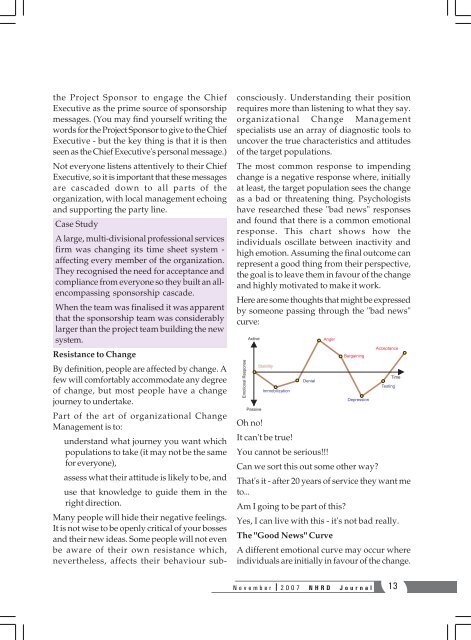NHRD Journal - National HRD Network
NHRD Journal - National HRD Network
NHRD Journal - National HRD Network
Create successful ePaper yourself
Turn your PDF publications into a flip-book with our unique Google optimized e-Paper software.
the Project Sponsor to engage the Chief<br />
Executive as the prime source of sponsorship<br />
messages. (You may find yourself writing the<br />
words for the Project Sponsor to give to the Chief<br />
Executive - but the key thing is that it is then<br />
seen as the Chief Executive's personal message.)<br />
Not everyone listens attentively to their Chief<br />
Executive, so it is important that these messages<br />
are cascaded down to all parts of the<br />
organization, with local management echoing<br />
and supporting the party line.<br />
Case Study<br />
A large, multi-divisional professional services<br />
firm was changing its time sheet system -<br />
affecting every member of the organization.<br />
They recognised the need for acceptance and<br />
compliance from everyone so they built an allencompassing<br />
sponsorship cascade.<br />
When the team was finalised it was apparent<br />
that the sponsorship team was considerably<br />
larger than the project team building the new<br />
system.<br />
Resistance to Change<br />
By definition, people are affected by change. A<br />
few will comfortably accommodate any degree<br />
of change, but most people have a change<br />
journey to undertake.<br />
Part of the art of organizational Change<br />
Management is to:<br />
understand what journey you want which<br />
populations to take (it may not be the same<br />
for everyone),<br />
assess what their attitude is likely to be, and<br />
use that knowledge to guide them in the<br />
right direction.<br />
Many people will hide their negative feelings.<br />
It is not wise to be openly critical of your bosses<br />
and their new ideas. Some people will not even<br />
be aware of their own resistance which,<br />
nevertheless, affects their behaviour subconsciously.<br />
Understanding their position<br />
requires more than listening to what they say.<br />
organizational Change Management<br />
specialists use an array of diagnostic tools to<br />
uncover the true characteristics and attitudes<br />
of the target populations.<br />
The most common response to impending<br />
change is a negative response where, initially<br />
at least, the target population sees the change<br />
as a bad or threatening thing. Psychologists<br />
have researched these "bad news" responses<br />
and found that there is a common emotional<br />
response. This chart shows how the<br />
individuals oscillate between inactivity and<br />
high emotion. Assuming the final outcome can<br />
represent a good thing from their perspective,<br />
the goal is to leave them in favour of the change<br />
and highly motivated to make it work.<br />
Here are some thoughts that might be expressed<br />
by someone passing through the "bad news"<br />
curve:<br />
Oh no!<br />
It can't be true!<br />
You cannot be serious!!!<br />
Can we sort this out some other way?<br />
That's it - after 20 years of service they want me<br />
to...<br />
Am I going to be part of this?<br />
Yes, I can live with this - it's not bad really.<br />
The "Good News" Curve<br />
A different emotional curve may occur where<br />
individuals are initially in favour of the change.<br />
November 2007 <strong>N<strong>HRD</strong></strong> <strong>Journal</strong> 13
















